
2017 Microchip Technology Inc.
DS20005747A-page 1
MD1813
Features
• 6 ns Rise and Fall Time
• 2A Peak Output Source and Sink Currents
• 1.8V to 5V Input CMOS Compatible
• Smart Logic Threshold
• Low-jitter Design
• Four Matched Channels
• Drives Two N-channel and Two P-channel
MOSFETs
• Outputs can Swing below Ground
• Built-in Level Translator for Negative Gate Bias
• Non-inverting Gate Driver OUTD for Easy Logic
• Low-inductance Quad Flat No-lead Package
• Thermally Enhanced Package
Applications
• Ultrasound PN Code Transmitter
• Medical Ultrasound Imaging
• Piezoelectric Transducer Drivers
• Non-destructive Testing
• High-speed Level Translator
• High-voltage Bipolar Pulser
General Description
The MD1813 is a high-speed quad-MOSFET driver.
It is designed to drive two N-channel and two
P-channel, high-voltage, DMOS FETs for medical
ultrasound applications and may be used in any
application requiring a high output current for a
capacitive load. The input stage of the MD1813 is a
high-speed level translator that is able to operate from
logic input signals of 1.8V to 5V amplitude. An adaptive
threshold circuit is used to set the level translator
threshold to the average of the input logic 0 and logic 1
levels. The level translator uses a proprietary circuit,
which provides DC coupling together with high-speed
operation.
The output stage of the MD1813 has separate power
connections, enabling the output signal L and H levels
to be chosen independently from the driver supply
voltages. As an example, the input logic levels may be
0V and 1.8V, the control logic may be powered by
+5V and –5V and the output L and H levels may be
varied anywhere over the range of –5V to +5V. The
output stage is capable of peak currents of up to ±2
amps, depending on the supply voltages used and load
capacitance. The OE pin serves a dual purpose. First,
its logic H level is used to compute the threshold
voltage level for the channel input level translators.
Second, when OE is low, the outputs are disabled, with
the A output high and the B output low. This assists in
properly pre-charging the coupling capacitors that may
be used in series in the gate drive circuit of an external
PMOS and NMOS. A built-in level shifter is for PMOS
gate negative bias driving. It enables the user-defined
damping control to generate return-to-zero bipolar
output pulses. The MD1813 has a non-inverting driver
OUTD for easy logic.
Package Type
16-lead QFN
(Top view)
See
Table 2-1
for pin information.
1
High-Speed Quad-MOSFET Driver
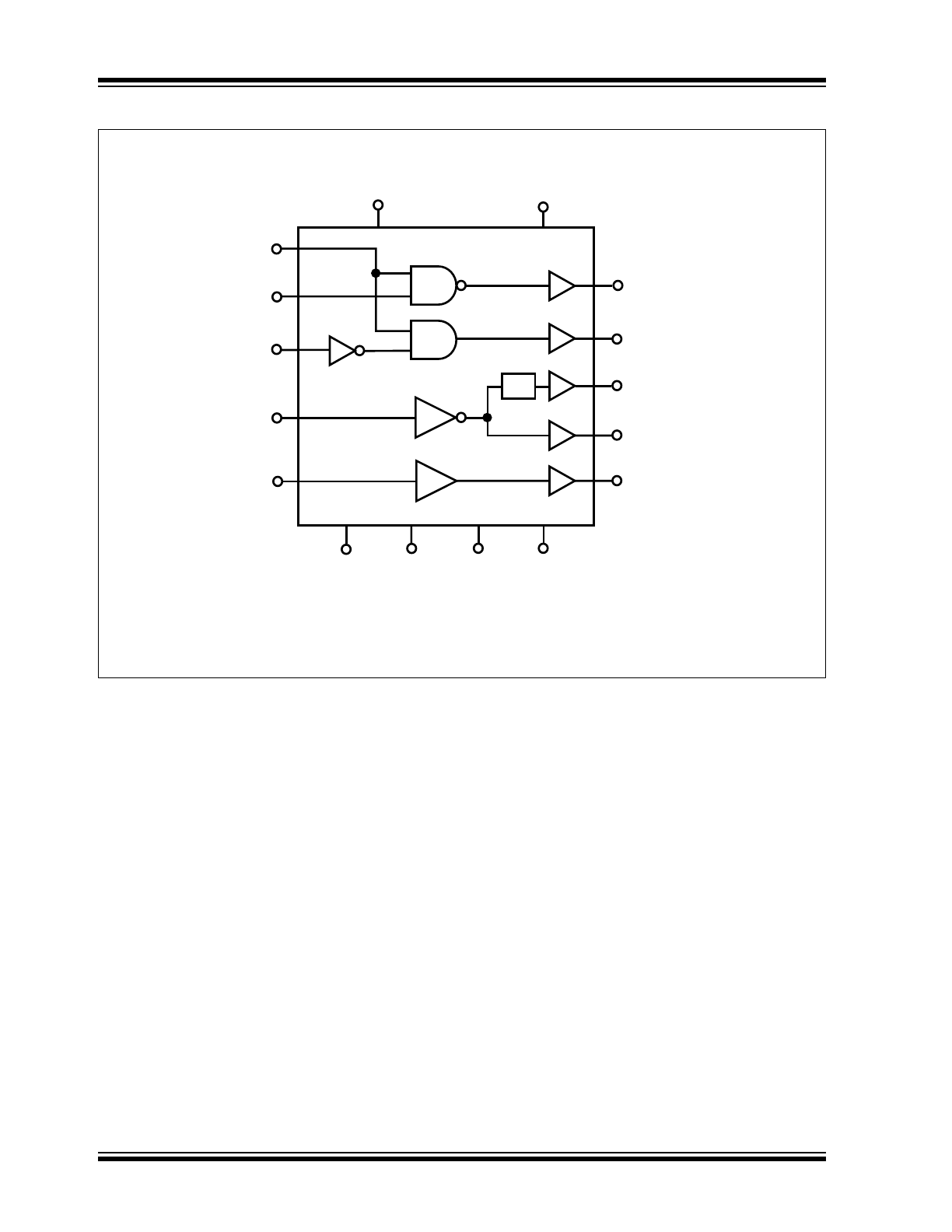
OUTA
INA
OUTB
INC
IND
LT
OUTG
OE
INB
VSS
GND
VL
VNEG
VDD
VH
MD1813
OUTD
OUTC
MD1813
DS20005747A-page 2
2017 Microchip Technology Inc.
Functional Block Diagram
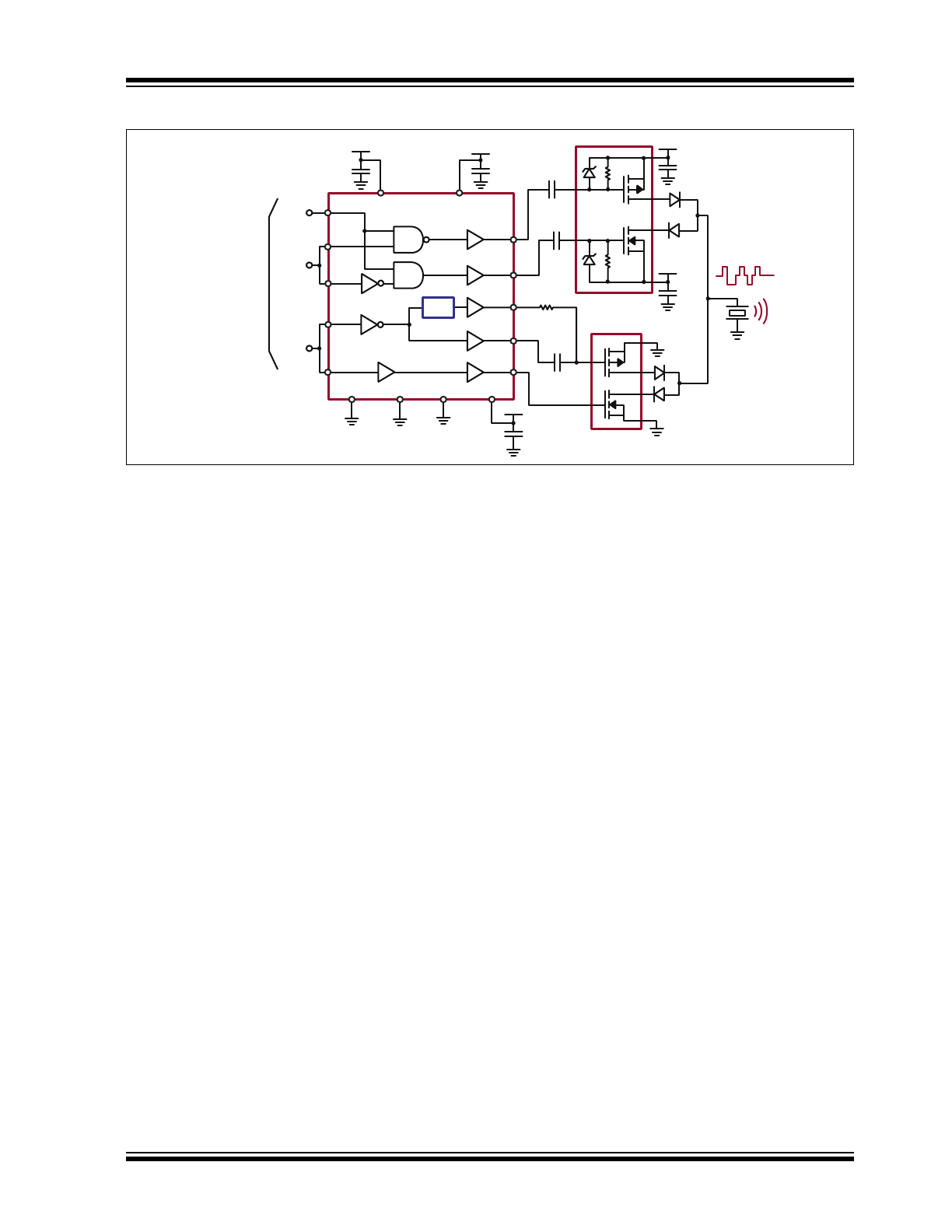
2017 Microchip Technology Inc.
DS20005747A-page 3
MD1813
Typical Application Circuit
-8.0V
MD1813
0.47μF
0.47μF
+10V
0.22μF
+10V
PULSE
DAMP
OUTA
OUTB
OUTC
OUTD
VDD
VH
VSS
VL
VNEG
GND
LT
2.0k
OUTG
TC2320
TC6320
1.0μF
1.0μF
10nF
10nF
10nF
INA
INB
INC
IND
3.3V CMOS
Logic Inputs
+100V
-100V
ENAB
OE

MD1813
DS20005747A-page 4
2017 Microchip Technology Inc.
1.0
ELECTRICAL CHARACTERISTICS
Absolute Maximum Ratings†
Supply Voltage, V
DD
–V
SS
..................................................................................................................... –0.5V to +13.5V
Output High Supply Voltage, V
H
.................................................................................................. V
L
–0.5V to V
DD
+0.5V
Output Low Supply Voltage, V
L
.................................................................................................... V
SS
–0.5V to V
H
+0.5V
Low-side Supply Voltage, V
SS
................................................................................................................... –7V to +0.5V
Supply Voltage, V
DD
–V
NEG
..................................................................................................................... –0.5V to +20V
Negative Supply Voltage, V
NEG
–V
SS
......................................................................................... V
SS
–10V to V
SS
+0.5V
Logic Input Levels ...................................................................................................................... V
SS
–0.5V to GND +7V
Maximum Junction Temperature, T
J
................................................................................................................... +125°C
Operating Ambient Temperature, T
A
.................................................................................................... –20°C to +85°C
Storage Temperature, T
S
..................................................................................................................... –65°C to +150°C
Power Dissipation ................................................................................................................................................... 2.2W
ESD Rating (
Note 1
) ............................................................................................................................... ESD Sensitive
† Notice: Stresses above those listed under “Absolute Maximum Ratings” may cause permanent damage to the
device. This is a stress rating only, and functional operation of the device at those or any other conditions above those
indicated in the operational sections of this specification is not intended. Exposure to maximum rating conditions for
extended periods may affect device reliability.
Note 1: Device is ESD sensitive. Handling precautions are recommended.
DC ELECTRICAL CHARACTERISTICS
Electrical Specifications: V
H
= V
DD
= 12V, V
L
= V
SS
= GND = 0V, V
NEG
= –6V, V
OE
= 3.3V and T
A
= 25°C
Parameter
Sym.
Min.
Typ.
Max.
Unit
Conditions
Supply Voltage
V
DD
–V
SS
4.5
—
13
V
2.5V ≤ V
DD
≤ 13V
Supply Voltage
V
DD
–V
NEG
—
—
18
V
Low-side Supply Voltage
V
SS
–5.5
—
0
V
Output High Supply Voltage
V
H
V
SS
+2
—
V
DD
V
Output Low Supply Voltage
V
L
V
SS
—
V
DD
–2
V
Negative Supply Voltage
V
NEG
–9
—
V
SS
–2
V
May be connected to V
SS
if
OUTG is not used.
V
DD
Quiescent Current
I
DDQ
—
1.5
—
mA
No input transitions, OE = 1
V
H
Quiescent Current
I
HQ
—
—
10
µA
V
NEG
Quiescent Current
I
NEGQ
—
150
—
µA
V
DD
Average Current
I
DD
—
7
—
mA
One channel on at 5 MHz,
no load
V
H
Average Current
I
H
—
22
—
mA
V
NEG
Average Current
I
NEG
—
1.5
—
mA
Input Logic Voltage High
V
IH
V
OE
–0.3
—
5
V
For logic inputs INA, INB, INC
and IND
Input logic Voltage Low
V
IL
0
—
0.3
V
Input Logic Current High
I
IH
—
—
1
µA
Input Logic Current Low
I
IL
—
—
1
µA
OE Input Logic Voltage High
V
IH
1.7
—
5
V
For logic input OE
OE Input Logic Voltage Low
V
IL
0
—
0.3
V
OE Input Resistance
R
IN
10
20
30
kΩ
Logic Input Capacitance
C
IN
—
5
10
pF
Output Sink Resistance
OUTA-D
R
SINK
—
—
12.5
Ω
I
SINK
= 50 mA
OUTG
—
—
200
Ω
I
SINK
= 5 mA
Output Source
Resistance
OUTA-D
R
SOURCE
—
—
12.5
Ω
I
SOURCE
= 50 mA
OUTG
—
—
200
Ω
I
SOURCE
= 5 mA
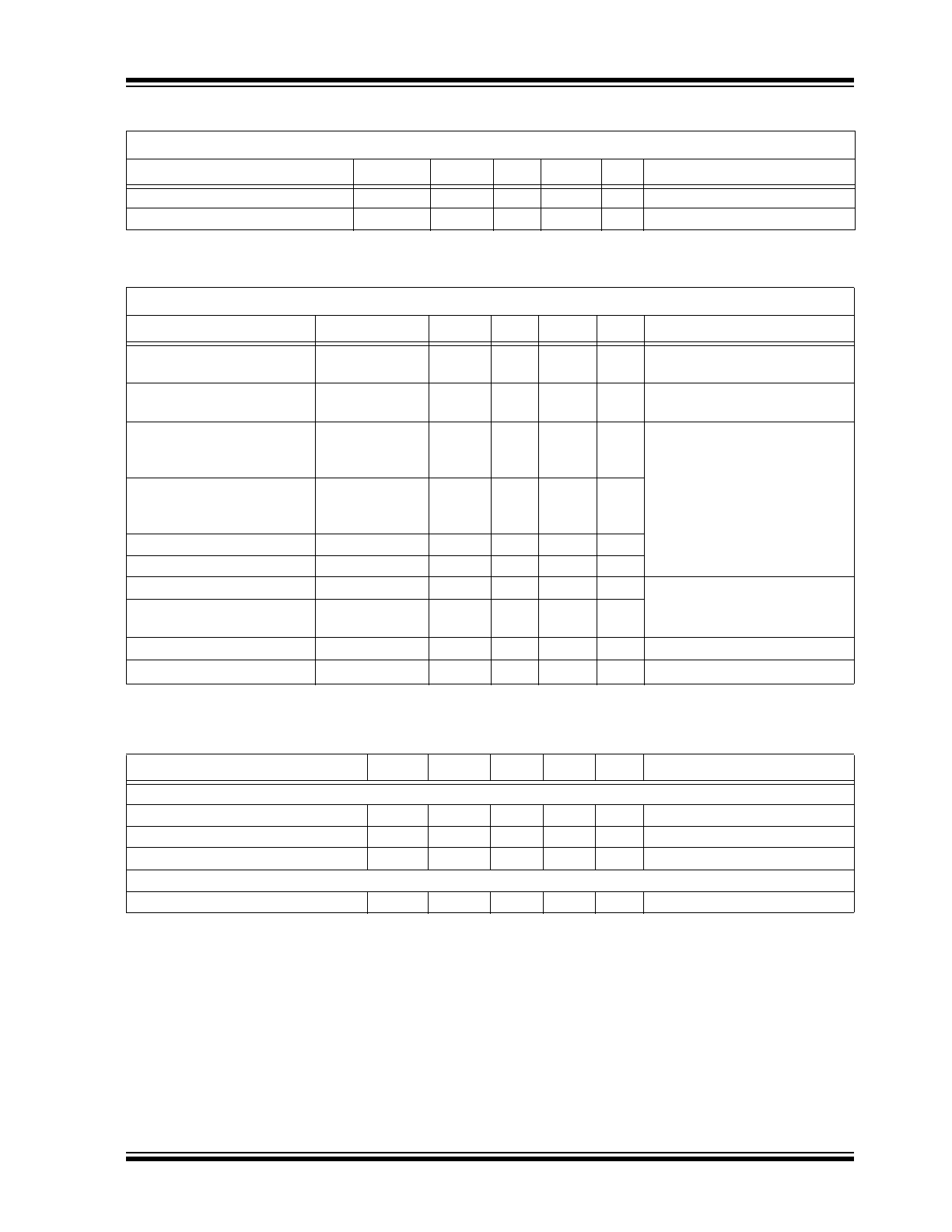
2017 Microchip Technology Inc.
DS20005747A-page 5
MD1813
TEMPERATURE SPECIFICATIONS
Parameter
Sym.
Min.
Typ.
Max.
Unit
Conditions
TEMPERATURE RANGE
Maximum Junction Temperature
T
J
—
—
+125
°C
Operating Ambient Temperature
T
A
–20
—
+85
°C
Storage Temperature
T
S
–65
—
+150
°C
PACKAGE THERMAL RESISTANCE
16-lead QFN
JA
—
25
—
°C/W
Note 1
Note 1: 1 oz. 4-layer 3” x 4” PCB
Peak Output Sink Current
I
SINK
—
2
—
A
Peak Output Source Current
I
SOURCE
—
2
—
A
AC ELECTRICAL CHARACTERISTICS
Electrical Specifications: V
H
= V
DD
= 12V, V
L
= V
SS
= GND = 0V, V
NEG
= –6V, V
OE
= 3.3V and T
A
= 25°C
Parameter
Sym.
Min.
Typ.
Max.
Unit
Conditions
Input or OE Rise and Fall
Time
t
irf
—
—
10
ns
Logic input edge speed
requirement
Propagation Delay INC to
OUTG
t
PCG
—
40
—
ns
10 MΩ load to GND
Propagation Delay when
Output is from Low to High
for OUTA-D
t
PLH
—
7
—
ns
C
LOAD
= 1000 pF, input signal
rise/fall time of 2 ns
(See
Timing Diagram
.)
Propagation Delay when
Output is from High to Low
for OUTA-D
t
PHL
—
7
—
ns
Output Rise Time
t
r
—
6
—
ns
Output Fall Time
t
f
—
6
—
ns
Rise and Fall Time Matching
l t
r
–t
f
l
—
1
—
ns
For each channel
Propagation Low-to-high and
High-to-low Matching
l t
PLH
–t
PHL
l
—
1
—
ns
Propagation Delay Matching
∆t
dm
—
±2
—
ns
Device-to-device delay match
Output Enable Time
t
POE
—
9
—
ns
DC ELECTRICAL CHARACTERISTICS (CONTINUED)
Electrical Specifications: V
H
= V
DD
= 12V, V
L
= V
SS
= GND = 0V, V
NEG
= –6V, V
OE
= 3.3V and T
A
= 25°C
Parameter
Sym.
Min.
Typ.
Max.
Unit
Conditions
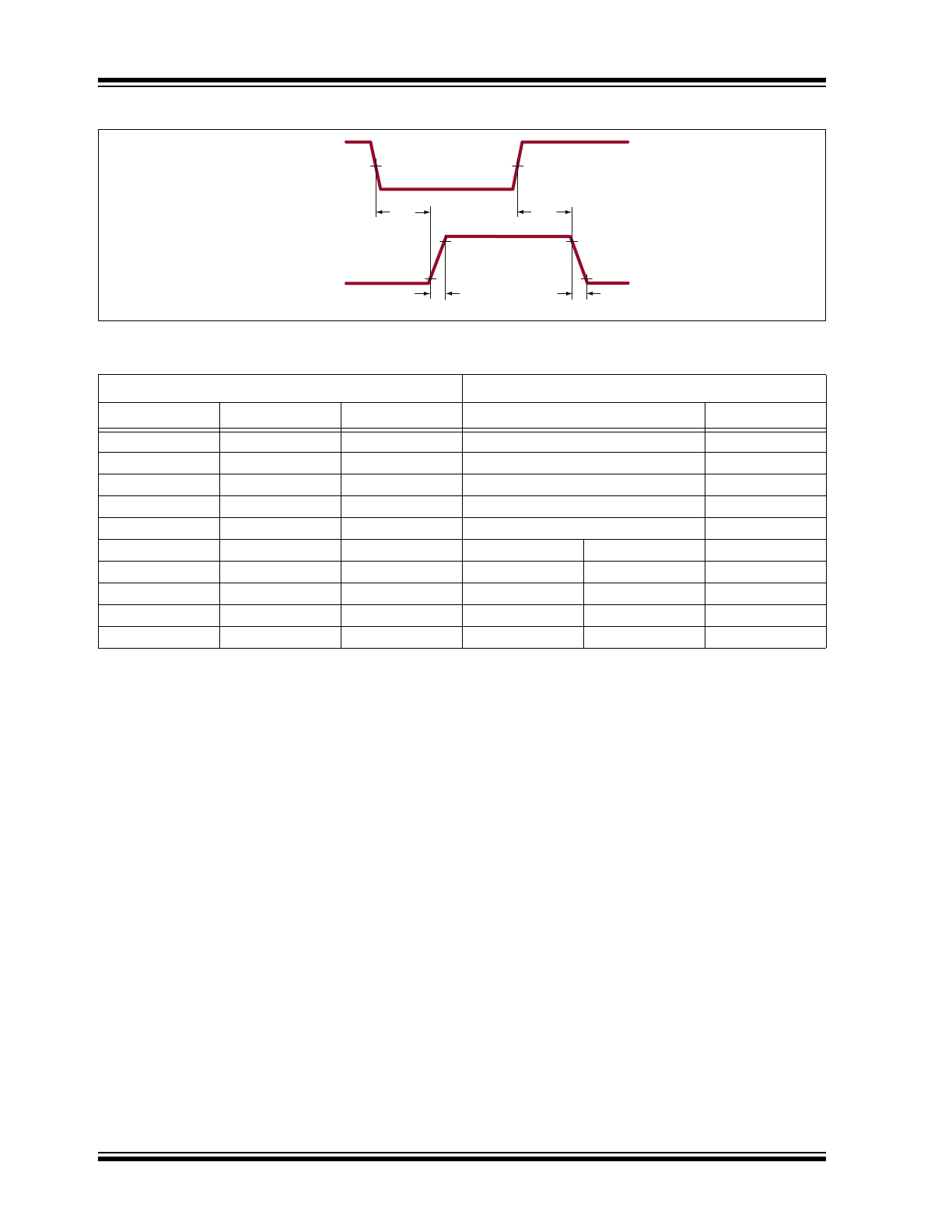
INPUT
t
PLH
10%
90%
50% 50%
OUTPUT
t
PHL
t
r
90%
10%
t
f
MD1813
DS20005747A-page 6
2017 Microchip Technology Inc.
Timing Diagram
TABLE 1-1:
TRUTH FUNCTION TABLE
Logic Inputs
Outputs
OE
INA
INB
OUTA
OUTB
H
L
L
V
H
V
H
H
L
H
V
H
V
L
H
H
L
V
L
V
H
H
H
H
V
L
V
L
L
X
X
V
H
V
L
OE
(
1
)
INC
IND
OUTC
OUTG
OUTD
(
2
)
—
L
L
V
H
V
SS
V
L
—
L
H
V
H
V
SS
V
H
—
H
L
V
L
V
NEG
V
L
—
H
H
V
L
V
NEG
V
H
Note 1: No control to OUTG, OUTC or OUTD
2: OUTD is non-inverting output.

2017 Microchip Technology Inc.
DS20005747A-page 7
MD1813
2.0
PIN DESCRIPTION
The details on the pins of MD1813 are listed on
Table 2-1
. See
Package Type
for the location of pins.
TABLE 2-1:
PIN FUNCTION TABLE
Pin Number
Pin Name
Description
1
INB
Logic input. Controls OUTB when OE is high.
2
VL
Supply voltage for N-channel output stage
3
GND
Device ground
4
VNEG
Supply voltage for the auxiliary gate drive. (
Note 1
)
5
INC
Logic input. Controls OUTC. Not controlled by OE.
6
IND
Logic input. Controls OUTD. Not controlled by OE.
7
VSS
Supply voltage for low-side analog, level shifter and gate drive circuit
8
OUTD
Output driver
9
OUTC
Output driver
10
OUTG
Not controlled by OE
11
VH
Supply voltage for P-channel output stage
12
OUTB
Output driver
13
OUTA
Output driver
14
VDD
Supply voltage for high-side analog, level shifter and gate drive circuit
15
INA
Logic input. Controls OUTA when OE is high.
16
OE
Output enable logic input (See
Figure 3-1
.)
Note 1: Thermal pad and pin 4, VNEG must be connected externally.

MD1813
DS20005747A-page 8
2017 Microchip Technology Inc.
3.0
APPLICATION INFORMATION
For proper operation of the MD1813, low-inductance
bypass capacitors should be used in the various supply
pins. The GND pin should be connected to the logic
ground. The INA, INB, INC, IND and OE pins should be
connected to a logic source with a swing of GND to
V
CC
, where V
CC
is 1.8V to 5V. Good trace practices
should be followed corresponding to the desired
operating speed. The internal circuitry of the MD1813
is capable of operating up to 100 MHz, with the primary
speed limitation being the loading effects of the load
capacitance. Because of this speed and the high
transient currents due to the capacitive loads, the
bypass capacitors should be as close to the chip pins
as possible. Unless the load specifically requires
bipolar drive, the V
SS
and V
L
pins should have
low-inductance feed-through connections directly to a
ground plane. If these voltages are not zero, they need
bypass capacitors in a manner similar to the positive
power supplies. The power connections V
DD
should
have a ceramic bypass capacitor to the ground plane
with short leads and decoupling components to prevent
resonance in the power leads.
Output drivers, OUTA and OUTC drive the gate of an
external P-channel MOSFET, while output drivers
OUTB and OUTD drive the gate of an external
N-channel MOSFET, and they all swing from V
H
to V
L
.
The auxiliary output drive, OUTG, swings from V
SS
to
V
NEG
, and drives the external P-channel MOSFET as
negative bias via a 2 kΩ series resistor.
The voltages of V
H
and V
L
decide the output signal
levels. These two pins can draw fast transient currents
of up to 2A, so they should be provided with an
appropriate bypass capacitor located next to the chip
pins. A ceramic capacitor of up to 1 µF may be
appropriate, with a series ferrite bead to prevent
resonance in the power supply lead going to the
capacitor. Pay particular attention to minimizing trace
lengths, current loop area, and using sufficient trace
width to reduce inductance. Surface-mount
components are highly recommended. Since the
output impedance of this driver is very low, in some
cases it may be desirable to add a small series resistor
in series with the output signal to obtain better
waveform transitions at the load terminals. This will
reduce the output voltage slew rate at the terminals of
a capacitive load.
The OE pin sets the threshold level of logic for inputs
(V
OE
+ V
GND
)/2. When OE is low, OUTA is at V
H
. OUTB
is at V
L
, regardless of the inputs INA and INB. This pin
will not control OUTC, OUTD or OUTG.
Ensure that parasitic couplings are minimized from the
output to the input signal terminals. The parasitic
feedback may cause oscillations or spurious waveform
shapes on the edges of signal transitions. Since the
input operates with signals down to 1.8V, even small
coupled voltages may cause problems. The use of a
solid ground plane and good power and signal layout
practices will prevent this problem. Make sure that a
circulating ground return current from a capacitive load
will not react with common inductance to cause noise
voltages in the input logic circuitry. Best timing
performance is obtained for OUTC when the voltage of
V
SS
– V
NEG
= V
H
– V
L
. When input logic is high, output
will swing to V
L
, and when input logic is low, output will
swing to V
H
. All inputs must be kept low until the device
is powered up.
V
OE
V
TH
0
0.5
1.0
1.5
2.0
0 1.0 2.0 3.0 4.0 5.0
0.6V
V
OE/2
V
TH
vs V
OE
FIGURE 3-1:
V
TH
/V
OE
Curve.

2017 Microchip Technology Inc.
DS20005747A-page 9
MD1813
4.0
PACKAGING INFORMATION
4.1
Package Marking Information
Legend: XX...X
Product Code or Customer-specific information
Y
Year code (last digit of calendar year)
YY
Year code (last 2 digits of calendar year)
WW
Week code (week of January 1 is week ‘01’)
NNN
Alphanumeric traceability code
Pb-free JEDEC
®
designator for Matte Tin (Sn)
*
This package is Pb-free. The Pb-free JEDEC designator ( )
can be found on the outer packaging for this package.
Note:
In the event the full Microchip part number cannot be marked on one line, it will
be carried over to the next line, thus limiting the number of available characters
for product code or customer-specific information. Package may or not include
the corporate logo.
3
e
3
e
16-lead QFN
Example
XXXXXX
XXXXXX
YYWW
NNN
e3
MD
1813K6
1714
895
e3
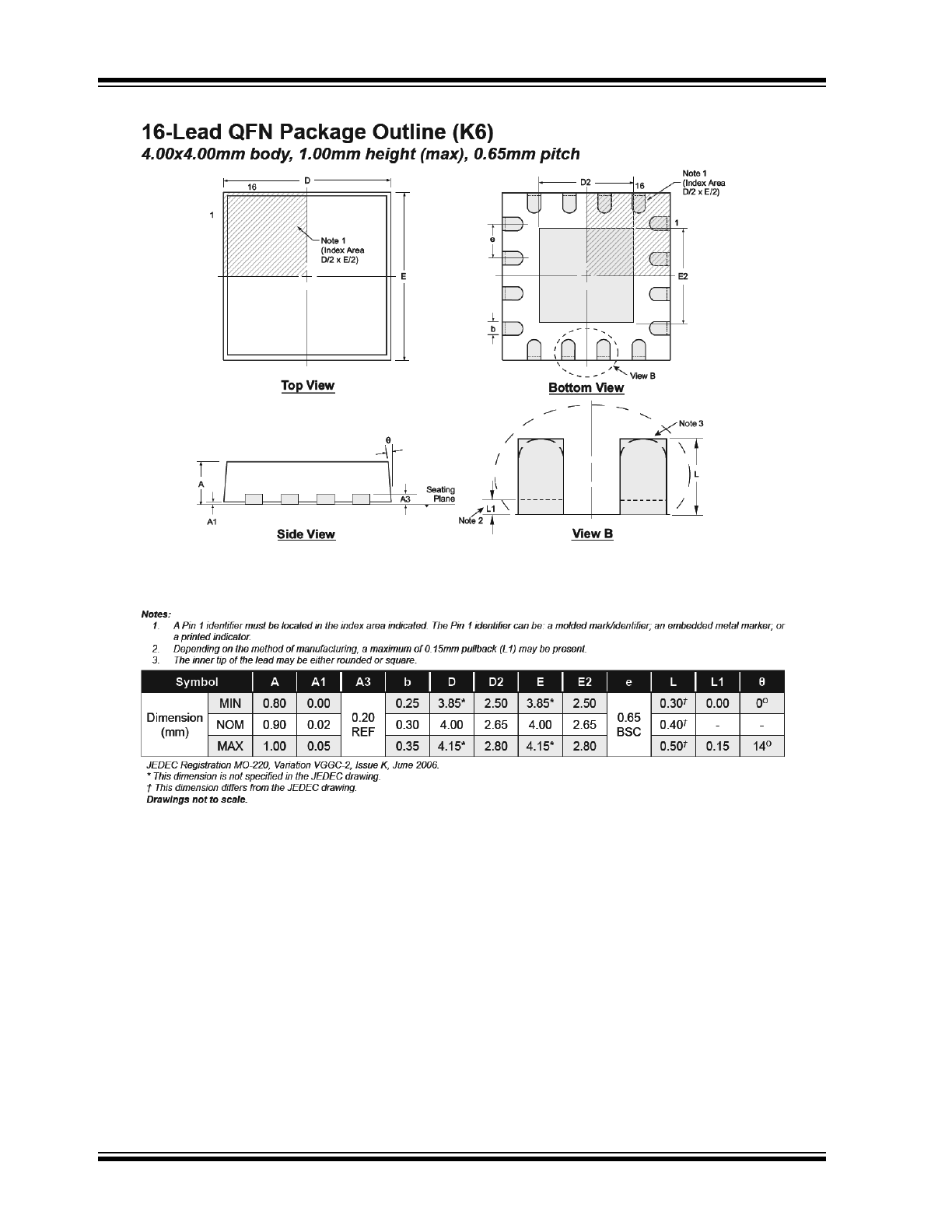
Note: For the most current package drawings, see the Microchip Packaging Specification at www.microchip.com/packaging.
MD1813
DS20005747A-page 10
2017 Microchip Technology Inc.
